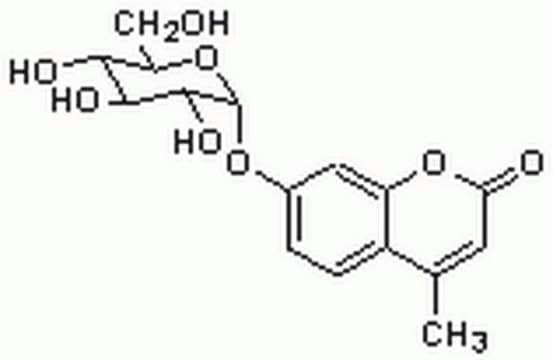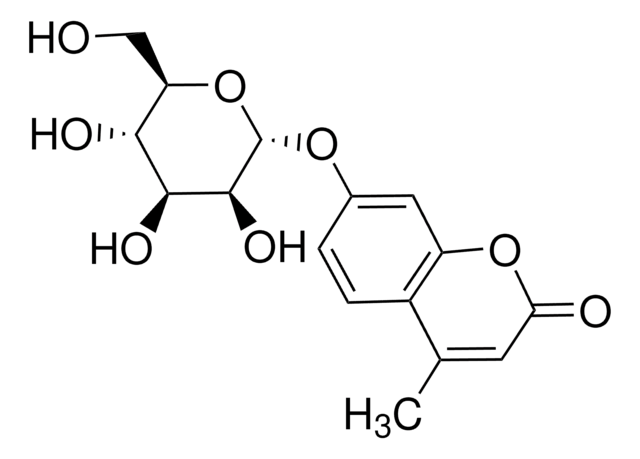69591
4-Methylumbelliferyl α-D-glucopyranoside
≥98% (TLC)
Synonim(y):
4-Methylumbelliferyl α-D-glucoside
About This Item
Polecane produkty
opis
α-glucosidase substrate
Poziom jakości
Próba
≥98% (TLC)
Postać
powder
rozpuszczalność
DMSO: 50 mg/mL, clear, colorless to faintly yellow
fluorescencja
λex 316 nm; λem 375 nm (Reaction product)
λex 317 nm; λem 374 nm (pH9.0)
λex 360 nm; λem 449 nm
λex 365 nm; λem 445 nm in 0.1 M Tris pH 8.0 (α-glucosidase)
temp. przechowywania
−20°C
ciąg SMILES
CC1=CC(=O)Oc2cc(O[C@H]3O[C@H](CO)[C@@H](O)[C@H](O)[C@H]3O)ccc12
InChI
1S/C16H18O8/c1-7-4-12(18)23-10-5-8(2-3-9(7)10)22-16-15(21)14(20)13(19)11(6-17)24-16/h2-5,11,13-17,19-21H,6H2,1H3/t11-,13-,14+,15-,16+/m1/s1
Klucz InChI
YUDPTGPSBJVHCN-JZYAIQKZSA-N
Szukasz podobnych produktów? Odwiedź Przewodnik dotyczący porównywania produktów
Opis ogólny
Zastosowanie
Opakowanie
Kod klasy składowania
11 - Combustible Solids
Klasa zagrożenia wodnego (WGK)
WGK 3
Temperatura zapłonu (°F)
Not applicable
Temperatura zapłonu (°C)
Not applicable
Środki ochrony indywidualnej
Eyeshields, Gloves, type N95 (US)
Certyfikaty analizy (CoA)
Poszukaj Certyfikaty analizy (CoA), wpisując numer partii/serii produktów. Numery serii i partii można znaleźć na etykiecie produktu po słowach „seria” lub „partia”.
Masz już ten produkt?
Dokumenty związane z niedawno zakupionymi produktami zostały zamieszczone w Bibliotece dokumentów.
Klienci oglądali również te produkty
Nasz zespół naukowców ma doświadczenie we wszystkich obszarach badań, w tym w naukach przyrodniczych, materiałoznawstwie, syntezie chemicznej, chromatografii, analityce i wielu innych dziedzinach.
Skontaktuj się z zespołem ds. pomocy technicznej

















